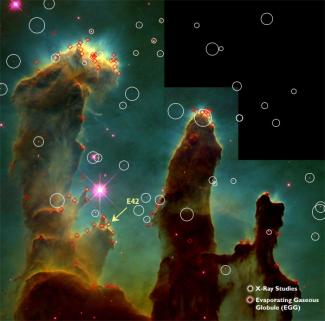Our Sun and its eight planets were born in a rough neighborhood nearly 5 billion years ago. Since then our star has traveled countless light years through the Milky Way, and our planet Earth has evolved the only intelligent life we know of in the Universe. Now, Earth's progeny are seeking to understand not only their own origins, but those of the Sun and its planets. They've discovered that our currently hospitable water planet and its dependable medium-sized star were likely born in a turbulent and chaotic cloud of dust and gas, blasted into existence by intense UV radiation from nearby massive stars and pummeled by shockwaves from one or more supernovae.
This growing understanding of our Sun's origins comes from observations of stellar nurseries such as the famous Pillars of Creation in the Eagle Nebula, shown at right. By analyzing visual, infrared, and X-ray emissions from these pillars, JILA Fellow Jeff Linsky and his colleagues from West Chester University, the University of Exeter and the University of Arizona have identified a Sun-like protostar on the edge of the tallest pillar on the left, underneath a very bright star.
The protostar is inside an evaporating gaseous globule (EGG), one of 73 such structures visible on the pillars (red diamonds). The creation of these EGGs began when a shock wave from a nearby hot star compressed regions of cold gas inside the pillars, creating dense protostellar cores. Then relentless UV bombardment from many other massive stars scoured away the surfaces of the pillars, revealing the EGGs. Eventually, such a process either evaporates the EGG core or produces a star with a planetary system. Recent studies of the pillars indicated that only 11 of the 73 EGGs contained a "young stellar object," and only four of these were actually massive enough to form a star. Only one, known as E42, had as much mass as our Sun.
Neither E42 nor the other three most massive EGGs emitted X-rays as did more mature, hotter stars in this region of the Eagle Nebula, according to a recent study (white circles) by Linsky and his colleagues. Linsky says this finding means that the four protostars forming on the edges of the pillars could well be the youngest stars ever imaged by astronomers. As newborn stars, they existed in a harsh radiation environment.
The intense UV radiation from nearby massive stars prematurely halted the formation of the protostars and their associated disks. Worse yet, these stars didn't shine very long before they blew up in cataclysmic supernovae, making them very dangerous neighbors indeed. In fact, astronomers recently observed a supernova close enough to the Pillars of Creation that its shockwave likely overtook and obliterated the pillars 6000 years ago. Because they are 7000 light years away from Earth, we won't witness that catastrophe for another thousand years.
So what was the fate of the young proto-Sun? If it hadn't yet become dense enough to ignite nuclear reactions in its core, it may have been destroyed by the shockwave. If the young star was dense enough for nuclear reactions to begin, it likely survived. The fate of any planets, however, remains unknown.
The amazing thing is that our Sun and planets somehow survived an equally rough environment in the beginning, including at least one supernova. We know about the supernova because our solar system captured oxygen, calcium, aluminum, and a host of heavy metals from it. Since then, our solar system, born in a blowtorch and fashioned from star dust, has wandered so long through space until we no longer know our birthplace. All we know is that is was a harsh and brutal spot. Since those days, however, we've settled down in the relatively safe and quiet suburbs of the Milky Way, where it has been possible for Earth to evolve intelligent life forms who wonder where they came from. - Julie Phillips




